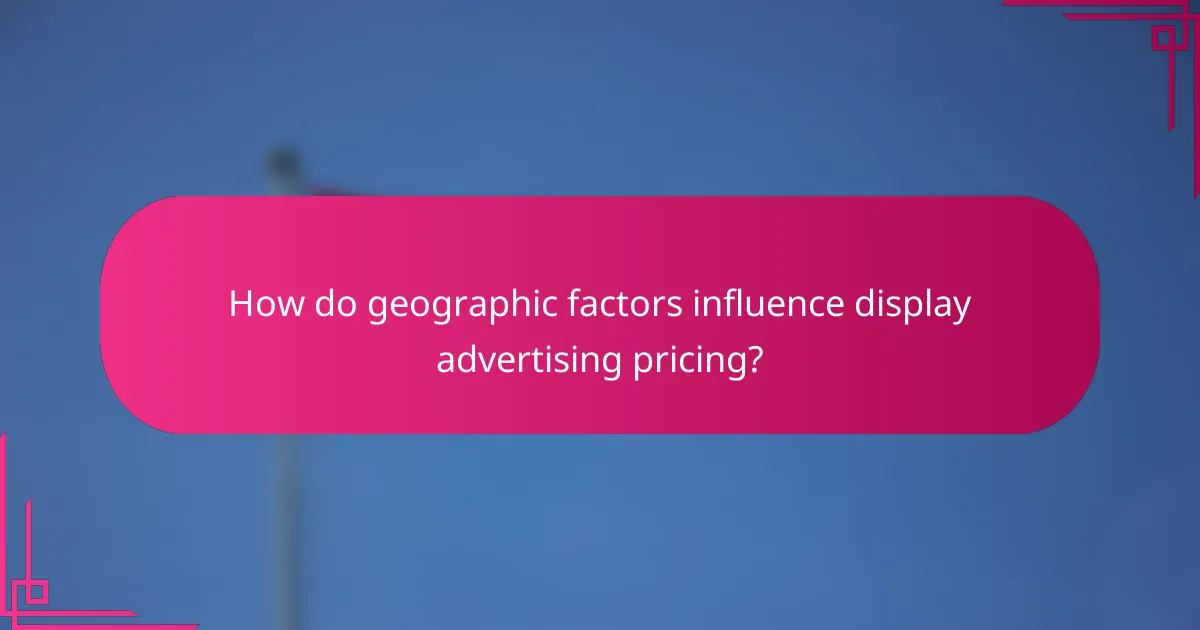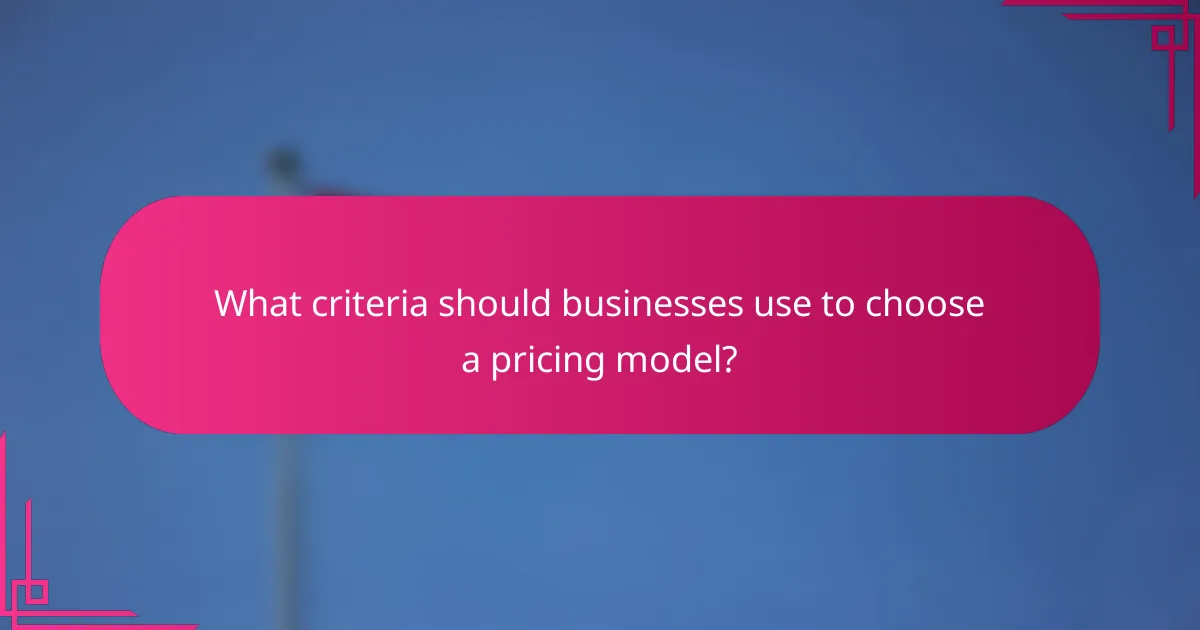Display advertising pricing models play a crucial role in shaping the effectiveness of online marketing campaigns. Common models such as Cost Per Mille (CPM), Cost Per Click (CPC), and Cost Per Acquisition (CPA) each come with unique benefits and drawbacks, influencing how advertisers allocate their budgets. Understanding these models is essential for aligning advertising strategies with specific campaign goals and maximizing return on investment.

What are the most common display advertising pricing models?
The most common display advertising pricing models include Cost Per Mille (CPM), Cost Per Click (CPC), Cost Per Acquisition (CPA), Cost Per View (CPV), and Flat Rate Pricing. Each model offers distinct advantages and drawbacks, making it essential for advertisers to choose the one that aligns with their campaign goals and budget.
Cost Per Mille (CPM)
Cost Per Mille (CPM) refers to the cost of displaying an ad one thousand times. This model is primarily used for brand awareness campaigns where impressions are more valuable than direct interactions. Advertisers pay a set fee for every thousand impressions, which can range from a few dollars to several hundred, depending on the platform and audience targeting.
When using CPM, it’s crucial to consider the quality of impressions. High-quality placements on reputable sites may cost more but can yield better brand visibility. Advertisers should monitor metrics like viewability and engagement to ensure their investment is effective.
Cost Per Click (CPC)
Cost Per Click (CPC) is a pricing model where advertisers pay each time a user clicks on their ad. This model is ideal for campaigns focused on driving traffic to a website or generating leads. CPC rates can vary widely, typically ranging from a few cents to several dollars per click, depending on the competition for keywords and audience targeting.
To optimize CPC campaigns, advertisers should focus on creating compelling ad copy and targeting the right audience. It’s also beneficial to conduct A/B testing on different ad variations to determine which generates the highest click-through rates.
Cost Per Acquisition (CPA)
Cost Per Acquisition (CPA) is a model where advertisers pay only when a user completes a specific action, such as making a purchase or signing up for a newsletter. This model is particularly effective for performance-driven campaigns, as it directly ties costs to conversions. CPA rates can vary significantly based on the industry and the value of the action taken.
Advertisers should ensure that their tracking systems are robust to accurately measure conversions. Additionally, setting a reasonable CPA target can help manage budgets effectively while maximizing return on investment.
Cost Per View (CPV)
Cost Per View (CPV) is commonly used in video advertising, where advertisers pay for each view of their video ad. This model is suitable for campaigns aiming to increase video engagement and brand awareness. CPV rates can range from a few cents to a couple of dollars, depending on the platform and audience targeting.
To maximize the effectiveness of CPV campaigns, advertisers should focus on creating engaging video content that captures viewers’ attention quickly. Monitoring viewer retention rates can also provide insights into how well the content resonates with the audience.
Flat Rate Pricing
Flat Rate Pricing involves paying a fixed amount for ad placement over a specified period, regardless of impressions or clicks. This model is often used for sponsorships or premium placements on high-traffic websites. The costs can vary widely based on the site’s popularity and the duration of the ad placement.
When considering flat rate pricing, advertisers should evaluate the potential reach and engagement of the site. It’s essential to negotiate terms that align with campaign objectives and ensure that the chosen platform can deliver the desired audience effectively.

How do CPM and CPC compare in effectiveness?
CPM (Cost Per Mille) and CPC (Cost Per Click) serve different advertising goals, making their effectiveness context-dependent. CPM is generally more effective for brand awareness, while CPC is better suited for direct response campaigns aimed at driving immediate actions.
CPM for brand awareness
CPM focuses on impressions, charging advertisers for every thousand views of their ad. This model is ideal for campaigns that aim to increase visibility and brand recognition rather than immediate clicks. For example, a company launching a new product may use CPM to reach a broad audience, ensuring that their brand is seen by as many potential customers as possible.
When using CPM, consider the target audience and the platforms where your ads will appear. High-traffic sites can provide extensive exposure, but costs may vary significantly. It’s crucial to monitor engagement metrics to ensure that the impressions translate into brand recall.
CPC for direct response
CPC charges advertisers only when a user clicks on their ad, making it a cost-effective choice for campaigns focused on generating leads or sales. This model is particularly useful for e-commerce businesses looking to drive traffic to their websites. For instance, a retailer may use CPC to promote a limited-time offer, encouraging immediate purchases.
To maximize the effectiveness of CPC campaigns, optimize ad copy and targeting to attract clicks from the right audience. Setting a clear budget and bid strategy is essential, as costs can fluctuate based on competition for keywords. Regularly analyzing click-through rates and conversion rates can help refine your approach and improve ROI.

What are the benefits of using CPA pricing?
Cost Per Action (CPA) pricing offers advertisers a performance-based model where they pay only when a specific action is completed, such as a sale or lead. This approach aligns advertising costs with actual results, making it a popular choice for businesses looking to maximize their marketing budgets.
Performance-based payment
CPA pricing is fundamentally a performance-based payment model, which means advertisers only incur costs when desired actions occur. This reduces the risk associated with ad spending, as businesses are not paying for impressions or clicks that do not lead to conversions.
By focusing on actions rather than mere exposure, CPA ensures that marketing efforts are directly tied to measurable outcomes. This model encourages advertisers to optimize their campaigns for better performance, as their costs are directly linked to the success of their advertising efforts.
Higher ROI potential
One of the key advantages of CPA pricing is its potential for higher return on investment (ROI). Since advertisers only pay for successful conversions, they can allocate their budgets more effectively and focus on strategies that yield the best results. This often leads to improved overall campaign efficiency.
For example, if a business spends $1,000 on a CPA campaign and generates $5,000 in sales, the ROI can be calculated as 400%. This model incentivizes continuous improvement and testing, as advertisers seek to lower their CPA while increasing their conversion rates.

What drawbacks should advertisers consider with CPC?
Advertisers should be aware of several drawbacks associated with cost-per-click (CPC) pricing models. These include the risk of click fraud, which can inflate costs, and the inherent variability of expenses based on click volume, which can complicate budgeting and forecasting.
Click fraud risk
Click fraud is a significant concern in CPC advertising, where individuals or automated bots generate false clicks to increase costs for advertisers. This can lead to wasted budgets and skewed performance metrics. To mitigate this risk, advertisers should monitor click patterns and utilize fraud detection tools to identify suspicious activity.
Common signs of click fraud include unusually high click-through rates (CTR) from specific sources or geographic locations. Implementing IP filtering and regularly reviewing analytics can help in identifying and reducing fraudulent clicks.
Variable costs
CPC advertising can lead to unpredictable costs, as expenses fluctuate based on competition and demand for keywords. This variability can make it challenging for advertisers to maintain consistent budgets, especially in competitive markets. Advertisers should prepare for potential spikes in costs during peak times or when bidding against aggressive competitors.
To manage variable costs effectively, consider setting daily or monthly caps on spending and regularly reviewing campaign performance. This allows for adjustments to bids and budgets based on real-time data, helping to control overall advertising expenses.

How do geographic factors influence display advertising pricing?
Geographic factors significantly impact display advertising pricing by affecting market demand and competition. Advertisers often pay more in densely populated areas due to higher competition and greater audience reach.
Market competition in urban areas
In urban areas, the high concentration of businesses leads to increased competition for display advertising space. This competition drives up prices, as multiple advertisers vie for the same audience. For example, a display ad in a major city like New York may cost significantly more than in a rural area due to the larger potential customer base.
Advertisers should consider the competitive landscape when planning their budgets. Utilizing tools to analyze local competition can help in determining optimal bidding strategies and ad placements.
Regional audience targeting
Regional audience targeting allows advertisers to tailor their campaigns based on local demographics and preferences. This specificity can enhance engagement and conversion rates, making it a valuable strategy despite potentially higher costs in certain regions.
For instance, targeting ads in a tech-savvy region may yield better results for a tech product, justifying a higher investment. Advertisers should assess the cost-benefit ratio of targeting specific regions to maximize their return on investment.

What criteria should businesses use to choose a pricing model?
Businesses should consider their specific campaign goals, target audience, and budget constraints when selecting a pricing model for display advertising. Each model has distinct advantages and disadvantages that can impact overall effectiveness and return on investment.
Campaign goals
Defining clear campaign goals is crucial for selecting the right pricing model. For instance, if the objective is brand awareness, a Cost Per Mille (CPM) model may be more suitable, as it focuses on impressions. Conversely, if the aim is to drive conversions, a Cost Per Action (CPA) model might be more effective, as it charges based on completed actions.
Consider the desired outcomes and how they align with the pricing structure. For example, a business looking to increase website traffic might benefit from a Cost Per Click (CPC) model, where payment is based on clicks rather than impressions. This approach ensures that the budget is spent on actual engagement.
Additionally, it’s important to evaluate how each model fits within the overall marketing strategy. A multi-channel approach that integrates various pricing models can optimize results, allowing businesses to leverage the strengths of each model based on specific campaign phases or objectives.
